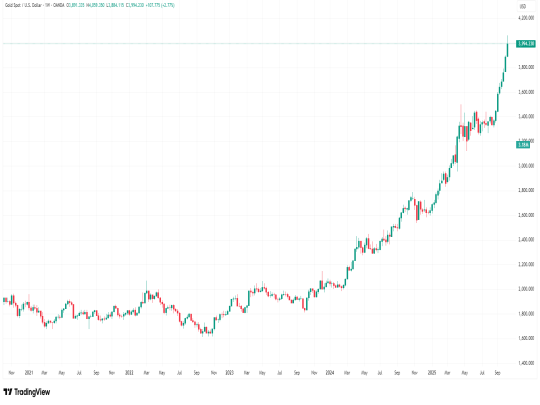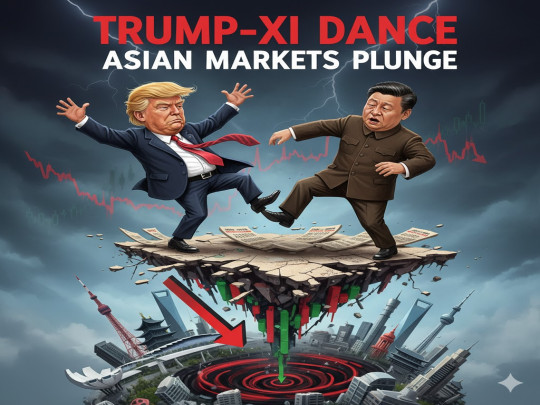Gold’s 2025 Breakout — and Why Prices Have Now Reversed
Gold’s 2025 rally captured headlines as spot bullion pierced the $4,000/oz level amid heavy ETF inflows, central-bank buying and a wave of safe-haven demand. After that blow-off leg, prices have pulledback—sometimes sharply—on a mix of technical, macro and event-driven triggers.

After a rapid advance through 2024 and into 2025, gold staged a fresh blow-off leg that sent spot prices to all-time highs above $4,000 per ounce. The move had been both broad-based and fast, producing outsized year-to-date returns and frequent intraday volatility. Technical indicators showed strong momentum, which typically increases both the odds of continuation and the likelihood of sharp, corrective pullbacks.
The Macro Cocktail Behind the Rally
Several interlocking forces explain why gold has become the market’s focal point:
- Monetary expectations and real yields. As markets price in an easing cycle for the Federal Reserve, the real (inflation-adjusted) yield on U.S. government debt has fallen — lowering the opportunity cost of holding non-yielding bullion and improving gold’s relative appeal versus fixed income. Lower real yields are one of the classic bullish drivers for gold.
- Dollar dynamics. A softer U.S. dollar amplifies demand from non-dollar investors and supports dollar-denominated commodity prices. Recent market surveys and positioning suggest strategists expect the dollar to remain under pressure through parts of 2025, a tailwind for bullion.
- Fund flows and retail participation. Massive inflows into physically backed gold ETFs have translated into sizeable physical purchases to back those funds. Global ETF flows reached record levels in recent months, and North American investors were major contributors to that surge. ETF demand has been a primary and immediate price driver.
- Official buying and geopolitical safe-haven demand. Central banks have resumed and in many cases increased gold purchases as part of reserve diversification, while geopolitical instability has revived gold’s traditional role as a crisis hedge. Together these buyers add a steady structural bid beneath prices.
Supply and demand realities (why tightness can persist)
Gold supply is relatively inelastic: mine output grows slowly and new mine development is multi-year and capital-intensive. Recycling responds to price, but it is not a one-for-one offset to surging investment demand. That supply backdrop, combined with concentrated buying from ETFs and central banks, helps explain how price can accelerate rapidly once momentum builds. Silver and other precious metals have mirrored and often amplified that move, reflecting both investment flows and industrial dynamics.
Why Prices Have Now Reversed
When a market moves quickly, the reversal is rarely attributable to a single cause. The recent pullback in gold reflects several interlocking dynamics:
- Short-term profit-taking and position squaring after a blow-off run. Rapid rallies invite profit-taking. Traders and funds that piled into long exposure during the spike often trim positions to lock gains once prices look overstretched. That initial selling can cascade in electronic markets, producing outsized intraday moves. Technical indicators (RSI, momentum oscillators) had signaled overbought conditions that made profit-taking more likely the moment buyers paused. Market commentators and technical desks flagged that the gold trade had become crowded and vulnerable to short squeezes in reverse.
- A firmer U.S. dollar and signs of stickier policy expectations. Gold is priced in dollars; a stronger dollar raises the effective cost of bullion for non-U.S. buyers and often triggers liquidation. In the recent window of reversal, the dollar regained some strength as markets digested Fed commentary and data that left the path of rate cuts less certain. Even muted hawkish noises from policymakers or warnings about persistent inflation can lift real yields, increasing the opportunity cost of holding non-yielding gold and putting downward pressure on prices. Public remarks by Fed officials urging caution have helped recalibrate market expectations.
- Easing of acute geopolitical risk and reduced immediate “panic” demand. Some short-term safe-haven flows that pushed prices higher were event-sensitive. When the acute intensity of a headline geopolitical event eases—such as reports of a ceasefire, de-escalation, or an agreed truce—conditional demand tied to that episode can subside, removing a portion of the recent buyer base and allowing prices to pull back. Even if underlying geopolitical risks remain elevated, the fading of an immediate trigger often produces a pause in buying.
- ETF positioning dynamics and liquidity mechanics. A large share of the 2025 advance came from ETFs that buy physical bullion to back share creation. That mechanism works both ways: when ETF flows reverse or slow, the physical support that helped lift prices can be absent. Additionally, that dynamic magnifies liquidity effects—large redemptions can force dealers to sell inventory into a market that had been buying. While the structural case (central-bank and retail demand) remains, ETF flows can be fickle and amplify reversals.
- Short covering and volatility feedback loops. Markets that become highly directional attract both momentum buyers and short sellers positioning for a pullback. When the first wave of profit-taking hits, algorithmic and leveraged funds can exacerbate moves as stop-losses trigger, creating a feedback loop of selling and short covering that magnifies the reversal beyond the initial fundamental signal. The net effect is sharp, sometimes violent, price swings even when the longer-term structural drivers remain intact.
How to watch for a durable trend change
A reversal can be temporary or mark a regime shift. Watch these markers to distinguish the two:
- Real yields and Fed communications: A sustained rise in real yields or clear hawkish guidance from the Fed would be a meaningful negative for gold.
- Dollar direction: A multi-week strengthening of the dollar against major currencies would increase downside risk for bullion.
- ETF flows and central-bank purchases: Renewed large scale inflows or continued central-bank buying would argue the dip is a buying opportunity; persistent outflows would confirm broader sentiment shift.
- Geopolitical developments: Fresh escalation or a new crisis could re-ignite safe-haven demand; conversely, sustained stabilization removes that support.
Bottom line
The recent reversal in gold is the product of normal market mechanics—profit-taking, technical overextension and liquidity feedback—overlaid with macro signals (dollar/real-yield shifts) and the temporary dissipation of event-driven safe-haven demand. For U.S. retail investors the key is to be explicit about your objective (hedge vs. speculation), choose a vehicle that matches that objective, size positions prudently and be prepared for two-way volatility even as you evaluate the longer-term case.


